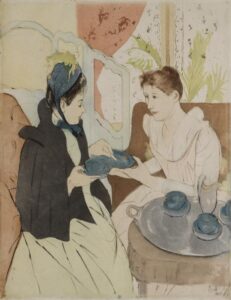Today’s post comes from Pilar Jefferson, class of 2015 and Art Center Student Docent.

Typically, when I’m in New York City visiting family for the weekend I take the A train all the way up to where the line ends in Inwood at the top of Manhattan. Two of the last stops before my station are 181st Street and 190th Street, and as the train slows to let passengers on and off I’m afforded a glimpse of the insides of those stations. The New York subway system is usually thought of as an anonymous space. Crowded in a train filled with strangers, everyone hurtles past thousands of lives above and around them that they will never know. So it was very surprising to me that in this world of anonymity the same artist who designed those glimpsed stations towards the end of the line on the A train would appear on the walls of the Frances Lehman Loeb Art Center.

The artist that I’m referring to is Squire Joseph Vickers, the unsung hero of the late NYC subway expansion. He is also the painter whose work Fantasy Castle with Men on Zebras (1923) is currently on view in the 20th century gallery at the Art Center. When I asked a 2 o’clock tour group last weekend to tell me what they noticed about the painting, two of the first commenters mentioned its vibrancy and two-dimensional quality. Fantasy Castle depicts an oblong tower, colored in striking shades of blue and red, with miniature guards and men riding zebras scattered along the ramp that climbs to the tower’s entrance. The sky in the background is painted with pastel blues, greens, and pinks like the sky before sunset. Both the sky and the building lie flat against the picture plane, distinguished from one another by the contrast of colors and the deliberate geometric sections Vickers paints.
This style reflects Vickers’s design concept utilized in the subway system. He was interested in color theory but also in efficiency. Vickers was hired in 1908 to replace the architectural firm of Heins & LaFarge, who had originally used the elaborate Beaux-Arts style to decorate the metal and cement of the subway stations and tunnels. He was influenced by the more streamlined styles of both the Arts and Crafts movement and, later, Art Deco. The unusual combination of the two, in addition to the budgetary constraints that Vickers was under to complete the subway project in the 1930s, led to the colorful mosaic tiling that lines the walls of subway stations today. “How grateful to the eye is the wall surface unbroken by paneling, noxious ornament or the misplaced string course, decorated, if you like, inlaid with color, but unbroken,” he wrote.

In a way Fantasy Castle is also a painted mosaic where each shape, whether figure, building or nature, geometrically fits together with a precision that reveals Vickers’s architectural background. At the same time, it is curious to imagine the straightforward urban designer spending his free time fantasizing about worlds in which men ride on zebras and buildings are painted in bold, bright colors. Perhaps it was the world that he wanted to build through his designs. Or maybe it was just a way to expand his mind, and relax a bit after the stress of designing one of the world’s most important public transportation systems. Either way, next time I take the subway I will be sure to look up from my phone or book more frequently, to see Vickers’s artistic vision, still alive and well beneath the streets of New York. And it is a pleasure to see the other side of his art on the walls of the Art Center.




